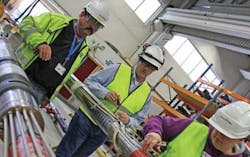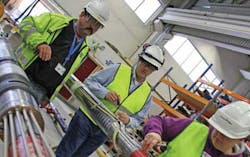Reevaluating the merits of smart wells
Dick Ghiselin
Contributing Editor
By definition, an intelligent well is one that has been equipped with instrumentation to monitor one or more well parameters, most likely temperature and pressure, plus some sort of servo-mechanism that can make changes based on the observations of the monitoring system. The earliest intelligent well systems (IWS) were associated with the wellhead, and consisted of surface mounted sensors and chokes, some variable, others simple open/shut devices.
Particularly useful in remote areas, the IWS, often powered by a solar panel, could be linked via a dial-up satellite communication system to the operators' production management facility. Upon observation of a problem, the well could be remotely shut-in to prevent damage and a repair crew dispatched at the earliest convenience to deal with the problem. In some cases, the system could be monitored in real time to diagnose dynamic production problems. Other systems stored well data in dial-up memory, so production staff could access the information as desired.
Within a short time, engineers realized the much greater value of downhole data, and many wells were equipped with permanent downhole gauges. Early versions were memory-only devices that required periodic retrieval to download data and replace batteries. But in the early 1990s, intelligent downhole systems that combined metrology with remotely operated downhole chokes were developed. Systems were either hydraulic, requiring control lines from the surface, or electrical, requiring power and telemetry cables. Early chokes had two positions—open or closed—and were essentially emergency shut-in devices. However within a short time, variable chokes were introduced. At first, these were multi-position devices that provided fixed flow rates, but later, infinitely variable chokes became available.
As the flow control devices were improved, so was the available metrology. Besides pressure and temperature, flow measurements were introduced, most using Venturi flowmeters. Later, multi-phase flowmeters were developed that provided valuable data to reservoir and production engineers. At first, choke reliability was limited. In high-rate wells, the choke apertures would be cut out within a short time, and an intervention was required to replace them.
Acceptance of IWS was slow. Many managers liked the concept, but balked at the cost. They thought that IWS was little more than an expensive toy, and that traditional production metrology located at the wellhead or the separator where it could be easily serviced was sufficient. By this time, many companies had expanded their production monitoring to the reservoir, using supervisory control and data acquisition (SCADA) networks to gather and combine data from several wells. Reservoir managers saw value in equipping all wells—producers, injectors, and observation wells—with SCADA.
Economic benefits realized
Traditional production operations involved numerous pumpers and gaugers who were responsible for visiting each wellhead and recording data from gauges and totalizer units, many of which were powered by fairly primitive mechanical clockwork systems. Often data was corrupted by delays in making the rounds, caused by weather, illness, or equipment failure. Human error was often the culprit. Sometimes, data was misreported, lost, or otherwise compromised. At the production office, engineers were overwhelmed with uncoordinated data, recorded on spreadsheets. Evaluation could take weeks, and once a recommendation was formulated and sent upstairs for a management decision, more time had expired. By then the well conditions had changed.
One of the most successful reservoir management systems has been implemented by Saudi Aramco in its Khurais complex, the world's largest IWS complex. The decision to invest in IWS was taken after the realization that using traditional data gathering techniques for the 100-plus wells would take 455 days. This was deemed unacceptable because any decision to alter the production (or injection) profile of one well had implications on all the other wells in the complex. The company engineers adopted a reservoir management cycle consisting of four phases: measurement and acquisition, validation and analysis, optimization and decision-taking, and implementation. For this to be effective, the entire cycle had to be turned quickly, before significant changes occurred. This required building a complementary infrastructure to support data gathering, validation, and processing. Wells had to be equipped with permanent downhole monitoring systems and flow control devices. A comprehensive 24/7 surveillance program had to be implemented. Norms can be used to identify problem wells, allowing engineers to focus on those wells needing attention instead of all the wells in the system.
Management buy-in was assured by building a complementary business case to support infrastructure development. The team showed that IWS could help maximize hydrocarbon production, recovery factor, and profitability, while improving health, safety, and environmental compliance. A key enabling factor was the use of automatic and remote simultaneous data gathering from each node of the system. This reduced the cycle time required to develop full reservoir understanding to three weeks.
Providing stronger incentives
Petrobras, with its massive offshore development issues, has recognized the need for a more comprehensive program to achieve optimum reservoir management. Experience of engineers trying to solve well issues has resulted in hardware and software interface problems. Accordingly, a study has been made to benchmark the current state-of-the-art technology. The "Digital Oilfield" concept is not yet fully developed within the company. People are still trying to solve individual problems without using an integrated workflow approach. Often, they implement bare minimum solutions aimed at solving specific problems without considering the implications on the entire reservoir, or on intra-division standardization.
A comprehensive inventory of state-of-the-art technology identified six electronic sensor technologies and two fiber optic ones. Starting with the traditional pressure and temperature gauges, which have been the backbone of the IWS data acquisition devices, they added quasi-distributed temperature systems. These involve the strategic placement of multiple gauges strung like Christmas lights on a single cable. Through multiplexing, their measurements can be transmitted to surface without interfering with one another. High-resolution resistance temperature devices (RTD) are the most modern available. Single-phase and two-phase flowmeters are now available that are based on measuring differential pressure. Single-phase venturi-type meters are useful in injector wells, while bi-phasic inverted venturi meters are used in high-rate production wells. More sophisticated multi-phase flowmeters are now available that contain densitometers.
Streaming potential can be measured using the century-old spontaneous potential (SP) log. Strongly influenced by fluid resistivity and differential pressure, SP indicates fluid flow through porous media surrounding the well. Interestingly, SP can be measured by a single electrode with no power source required. It is truly "spontaneous."
3D resistivity tools have been developed that are capable of inter-well tomography. These can perform time-lapse logs of the formation between the wells, giving indications of fluid movement where there exists a resistivity contrast, such as that caused by changing saturation. Similarly, permanent seabed or downhole seismic arrays can map fluid movement between wells using time-lapse (4D) effects. Seabed systems have an advantage over surface towed systems because the sensors do not move between surveys, eliminating several variables and accelerating processing. The upfront cost of a seabed system may be offset by subsequent economical 4D surveys and the resulting improvement in production efficiency and ultimate recovery.
A family of fiber optic measurements has recently been introduced that provides excellent reservoir evaluation. The earliest technique, distributed temperature sensing (DTS), is a permanent monitoring device that provides a top-to-bottom temperature profile sensitive to fluid movement and particularly gas incursion. DTS is now complemented by distributed acoustic survey (DAS) and distributed vibration sensing (DVS). These provide pressure and strain measurements that are useful in evaluating hydraulic fracturing treatments. An advantage of fiber optic systems is that the fiber itself is relatively inexpensive. Deployment options are numerous. It can be deployed and cemented in the annulus. It can be deployed inside a control line, where it can easily be replaced if necessary.
Making decisions easy
Cost factors are always at issue in any decision. Nowhere is cost control as evident as in deepwater development. According to recent literature, capital costs for IWS can range from $200,000 for a permanent downhole gauge system to $2.5 million for a multi-zone, remotely controlled completion. However, it has been postulated that deepwater intervention costs in the Gulf of Mexico can range between $30 million and $50 million. If a system eliminates a single intervention, it could pay for itself many times over.
Aside from reduction of interventions, other IWS value applications include improving production rates, extending estimated ultimate recovery, and improving reservoir management efficiency.
There is no question that to realize the full benefit of IWS in a reservoir management role, operators must adopt a similar approach to that taken by Saudi Aramco. The implications for the reservoir of making a change in one well are not to be overlooked. Managing a multi-well asset is a complex task that requires full understanding of reservoir dynamics as well as reservoir economics. The net present value of each incremental change in an individual well must be compared with the cost of the change to determine if the change is worthwhile. But trying to extrapolate this to the reservoir is practically impossible without the benefit of a valid dynamic model and coordinated workflows.
The complexity of economic decisions affecting the reservoir become exponential as the reservoir reaches maturity. Operators that forgo the opportunity to build a comprehensive reservoir management system early in the reservoir's life may pay a steep price later in terms of lost production or remediation expenses.
The role of ESPs
If $50-million interventions are too heady to grasp, the number of instrumented wells onshore has been growing. Since most wells eventually must submit to some form of artificial lift, the use of IWS techniques to justify the change was a natural evolution.
For several years, electric submersible pumps (ESP) have been used to produce oil wells or dewater gas wells. One way to maximize the profitability of ESPs is to equip them with smart systems that measure both well performance and pump performance.
Well performance can be optimized by making incremental changes in motor speed using a variable speed drive on the surface. Using downhole data that is multiplexed up the power cable and transmitted to the field production office, engineers can monitor well performance and take remedial action if warranted. At the same time, pump and motor parameters can be monitored to signal when the ESP needs attention.
The biggest cost items in wells equipped with ESPs are electrical power costs and lost production if the pump goes offline. By monitoring pump performance, electrical power usage can be minimized, and when the pump indicates that it needs attention soon, a replacement can be staged so well downtime is limited to the actual change-out time. This maximizes production time.
Not limited to land, recently very large ESPs have been installed in deepwater fields to lift the oil from the seabed gathering station to the floating production facility on the surface. In Shell's giant BC-10 development offshore Brazil, the floating production facility can efficiently process up to 100,000 b/d of oil, 75,000 b/d of injection water, and 50 MMcf/d of natural gas. Having an ESP go down for an extended period of time could cost millions.
Another important aspect is the ratio of wells to production. A mature onshore field may have 100-plus wells. If one goes down, the effect is relatively small. Modern offshore fields may contain less than 10 wells, yet total production volume can be more than that of a 100-well onshore field. The effect of one offshore well going down is huge compared to a land well. IWS can mitigate that risk.
Reviewing the benefits
The benefits of IWS from a reservoir management perspective transcend those of keeping a single well operating. Using centrally located production nodes interconnected to a network of downhole and surface well sensors, and administered using logical workflows and dynamic reservoir models, fewer production engineers can manage more wells more efficiently and more effectively. Armed with accurate, up-to-date information, reservoir engineers can plan infill wells, convert producers to injectors, shut in wells or plan interventions to rejuvenate under-performing wells -- all justified with solid economic backing and reduced risk.

